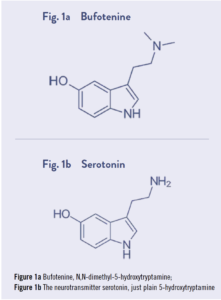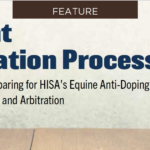By Clara Fenger, DVM, PhD, DACVIM; Peter J. Sacopulos, JD; Kimberly Brewer, DVM, MSc; Jacob Machin, MS; and Thomas Tobin, MRCVS, PhD, DABT
Function of the ubiquitous substance bufotenine remains unknown
Hay, oats and water. It should be simple.
If we only give horses hay, oats and water, we should be safe from positive tests that sully the name of horse racing, threaten trainers’ livelihoods and discourage owners who rarely win races or profit from their horses, all while safeguarding the health and welfare of the racehorses.
However, even as medication regulations have become stricter and stricter and horsemen and veterinarians have pulled back withdrawal times and limited the use of therapeutic medications, the rate of positive tests has doubled (albeit from 0.3 percent to 0.6 percent).
 Unfortunately, it is not as simple as decreasing the number of medications that we give horses. As we have repeatedly reported in these pages, positive tests are often beyond the control of veterinarians, horsemen and horsewomen.
Unfortunately, it is not as simple as decreasing the number of medications that we give horses. As we have repeatedly reported in these pages, positive tests are often beyond the control of veterinarians, horsemen and horsewomen.
Trace amounts of therapeutic medications have been identified days, weeks or even months beyond any possible effect (The Horsemen’s Journal Winter 2021, Winter 2020); trace levels of substances never intentionally administered to horses have been identified (The Horsemen’s Journal Fall 2021, Fall 2020, Summer 2020, Winter 2018, Summer 2018); and substances that are naturally occurring in hay, bedding and feed have been called positives (The Horsemen’s Journal Winter 2019, Spring 2019, Summer 2018). We are assaulted by daily reporting of positive tests, almost all of which are along these lines, with only a handful of intentional administrations of illicit substances.
One such naturally occurring substance is bufotenine. Bufotenine is well characterized as an endogenous alkaloid among both animals and plants. It has been detected commonly in mammals in urine and feces and less commonly in blood.
The biological function of this ubiquitous substance is unknown, other than to say that it is clearly a metabolite of the protein building block amino acid tryptophan.
Although closely related tryptamine compounds (dimethyltryptamine) have psychedelic properties, high doses of bufotenine, well above the levels present naturally, administered intravenously to a human volunteer resulted in profound anxiety but had no other effects.
Bufotenine, chemically N,N-dimethyl-5-hydroxytryptamine (Figure 1a), is a small molecule closely related to the well-known human/mammalian neurotransmitter serotonin (Figure 1b).
Of particular interest to the racing industry is the fact that bufotenine and its chemically related precursor 5-methoxy-N,N-dimethyltryptamine are also found in various plants, including reed canary grass (Phalaris arundinacea).
In addition to being an endogenous substance present at a low background concentration, bufotenine is routinely detectable in equine plasma and urine if the horses in question have grazed or been fed hay containing the common contaminant of hay fields, reed canary grass. The question that then arises is what represents a “normal” concentration of bufotenine in horse plasma and urine—and also what kind of plasma or urinary concentrations should be considered “abnormal.”
Further confounding the racing regulatory picture is that this alkaloid has long been the subject of myth as “frog juice,” a toad venom extract used for its hallucinogenic properties. It turns out that toads of the genus Bufo have a number of toxic principles in their venom, of which bufotenine is the least effective.
Nonetheless, bufotenine was first chemically identified in these toads, ergo the name. Toads of both the Bufo and Osteocephalus genera concentrate bufotenine in their salivary secretions and in their eggs, which serves as protection from predation, presumably because eating either the toad or their eggs produces adverse effects in predators.
The reports of such impressive effects of frog juice on mammals make the Horseracing Integrity and Safety Authority’s classification of this substance in the S0 (banned at all times) category no mystery.
However, as the substance is both endogenously produced in the animal and readily consumed as a component of hay, the proposed screening limit, identical to that of the International Federation of Horseracing Authorities at 10 micrograms per milliliter in urine, is appropriate. Inappropriate, however, is the lack of a matching plasma screening limit.
In studies in mammals to date, most were unable to find bufotenine in blood, owing to the lack of sensitivity of the methods employed. Horse racing laboratories are considerably more proficient at detecting low levels of substances than the laboratories that conducted these previous studies. This urine screening limit without a corresponding plasma/serum limit makes the penalizing limit of detection identifications in blood an arbitrary line. In the few human studies in which blood concentrations were reported, they range from 22 picograms per milliliter to 40 nanograms per milliliter (ng/mL), with the majority of samples below the limit of detection of the respective laboratories.
Unfortunately, restricting intake of all but hay, oats and water to horses is not as simple as it sounds.
The recent cluster of bufotenine positives in Pennsylvania in Standardbred and Thoroughbred racing, below the international threshold in urine in some cases and below the 40 ng/mL shown to be an endogenous level in human blood, underscores the problem with the current sensitivity of testing. American racing commissions have been slow to identify this problem with the limit of detection of endogenous and environmental substances, and it appears that HISA is not going to improve this inherently arbitrary regulation.
To read more of the challenges with medication regulations: download the publication in full – Winter 2022, Horseman’s Journal






